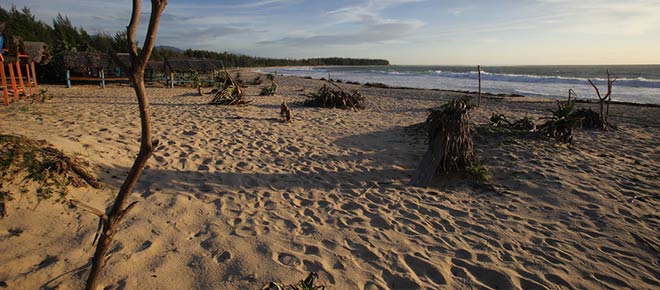The humanitarian response to the Indian Ocean Tsunami saved lives and gave people the means to rebuild their futures. 10 years on Oxfam provided details on how we responded.

The humanitarian response to the Indian Ocean Tsunami saved lives and gave people the means to rebuild their futures, Oxfam says today.
The tsunami on Boxing Day ten years ago was unprecedented. It hit 14 countries and affected 5 million people, killing an estimated 230,000 and leaving 1.7 million homeless.
An estimated US$13.5 billion was raised by the international community. Up to 40 per cent was donated by individuals, trusts, foundations and business, making it the highest ever privately funded emergency response. Oxfam New Zealand contributed almost NZ$2 million through generous donations from the public and an extra $1.3 million in matching grants from the New Zealand Government. This was the most any Oxfam emergency appeal has raised in New Zealand.
The funding meant that Oxfam was able to respond in seven countries – Indonesia, Sri Lanka, India, the Maldives, Myanmar, Thailand and Somalia, making it Oxfam’s largest emergency response ever. After Oxfam responded to the most pressing needs – emergency water, food and shelter – it had enough funding to improve livelihoods over a five-year period.
Rachael Le Mesurier, Oxfam New Zealand’s Chief Executive, said: “The tsunami unleashed destruction on an unprecedented scale which resulted in a global outpouring of compassion. The exceptional generosity of the New Zealand public and government meant Oxfam had the resources to stay with communities affected. Ten years on, we are still seeing the impact of Oxfam’s work. We can be proud of the legacy we leave in the region.”
Oxfam and its partners helped an estimated 2.5 million people between 2004 and 2009. In the immediate term, the international agency provided shelter for more than 40,000 people, providing blankets and clean water. Over the next three years, Oxfam continued to truck more than 300 million litres of water into Aceh, Indonesia, which was among the hardest hit.
Work from Oxfam and partners included improving or building more than 10,800 wells, 90 boreholes and 55 gravity flow water systems. In Aceh, a municipal system to supply 10,000 people was built and training provided for local communities to maintain it. A return trip to the communities in Aceh earlier this year confirmed that water systems are still running under the eye of local volunteers and that Oxfam’s wider response made a difference to people’s lives.
Oxfam also reached a further 960,000 people to help improve their incomes, either by recruiting people to help with clean-up projects or by restoring livelihoods such as replacing fishing boats, constructing docks in Indonesia and Somalia, improving agricultural practices and replacing livestock. Other work included constructing or repairing 100 schools in Indonesia and Myanmar.
Oxfam was part of a wider humanitarian effort, which succeeded in getting children back to school in all affected countries within the first six months. In that time, about half a million people had been temporarily housed in Aceh. The fishing industry in Sri Lanka was rapidly rebuilt, with more than 80 per cent of damaged boats, equipment and markets restored, and 70 per cent of households back on a steady income. Tourists had also begun returning to Thailand and the Maldives.
The humanitarian sector’s focus to ‘build back better’ means that new infrastructures are more able to withstand natural disasters and the communities can better cope by having access to healthcare and resources. One of the biggest lessons from the tsunami was the need to invest far more in reducing the risk of future disasters. The absence of an early warning system, which could have saved many lives further from the epicentre, has been addressed. The system was put to the test in 2012 following an earthquake in roughly the same location.
The scale of the disaster was not without its challenges and Oxfam and the wider humanitarian sector has learnt a lot from the experience. Different organisations, for example, are now responsible for different aspects of humanitarian responses – such as water and sanitation, logistics and shelter – so that they are more co-ordinated. Oxfam has also looked at streamlining work between different teams and on what it delivers in emergencies: providing safe water and sanitation, public health and livelihoods.
The tsunami attracted more media coverage in two months than the world’s top 10 ‘forgotten’ emergencies throughout the previous year and was one of the first disasters to be extensively captured on mobile phones as it happened.



